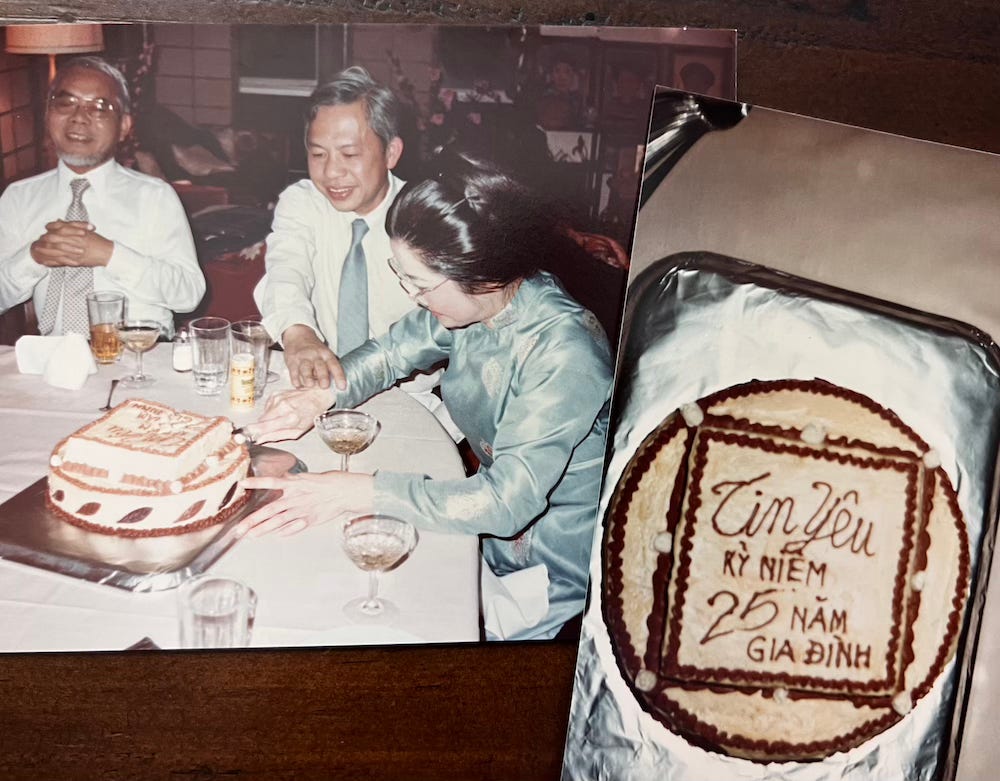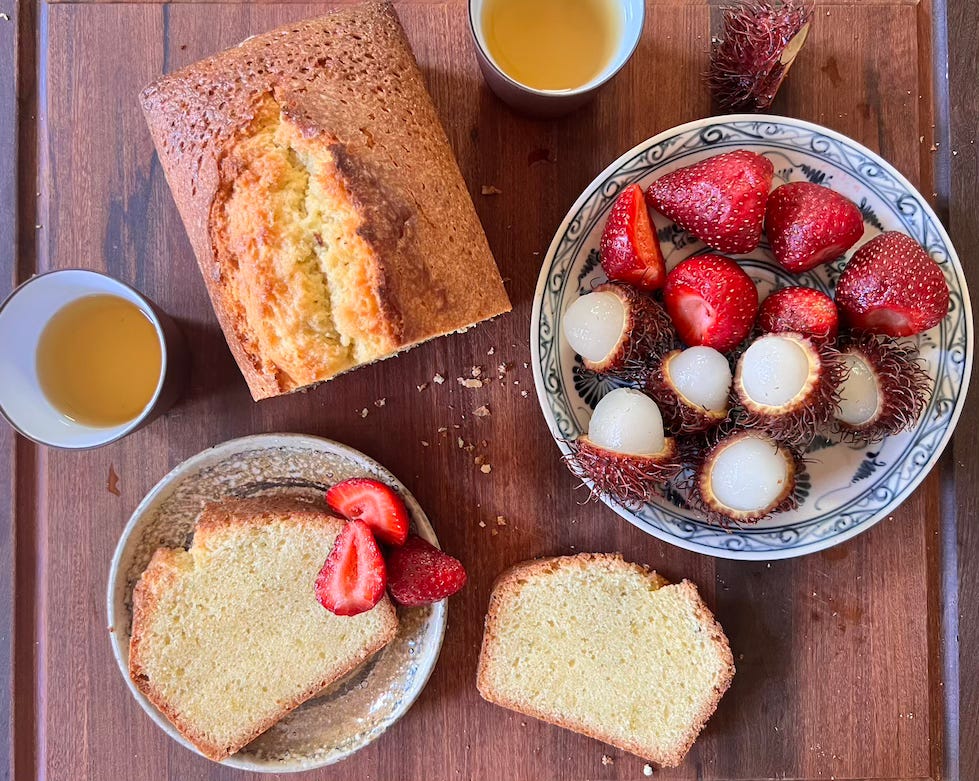Easy Lime Pound Cake: My Bánh Cake
+ why food processor and blenders make great pound cake + why Viet people love western baked goods
Why are Western baked goods a strong part of Vietnam’s cuisine?
Colonialism, exposure to western culture through war, trade, and social interactions. For all those reasons and more, there were and still are French-style bakeries in Vietnam, such as historic Brodard in Saigon, which opened in 1948 on Rue Catinat (now Đồng Khởi Street), the most fashionable street in the city.
The above historic photo from Virtual Saigon shows a Bata shoe shop next door. If you could afford the pastries and European import shoes, you were damn lucky.
When we still lived in Saigon, a trip to Brodard was for birthdays. French-style sweets were for the well-to-do and or special occasions. Butter, wheat flour, and granulated sugar were expensive.
When my family came to America, we suddenly could afford to bake western-style sweets to our heart’s delight. First up were French classics like cream puffs, dacquoise and puff pastry. My mom and older sister Linh were ambitious. They bought a used electric mixer at the thrift store. That explains why and how I got a buttercream frosted genoise for my birthday while my friends had store-bought or boxed cake mix cake for theirs.
My mom made a delicious cake to celebrate her and my dad’ 25th wedding anniversary in 1983. My dad likely did the writing in buttercream. “Tin yêu kỉ niệm 25 năm gia đình” means “Loving memories of 25 years of family life.”
Aside from cake, my mom kneaded water out of butter like a pro for homemade pâte feuilletée. One time, she folded a sheet of paper to estimate how many actual layers she was creating. Soon after she got both volumes of Mastering the Art of French Cooking, she began referring to Julia Child as “Julie”. They were fast kitchen friends.
From the Frenchy sweets, our family explored American treats, including pound cake. We didn’t know that pound cake originated in northern Europe in the 1700s and became popular in many places. The French version is called quatre-quarts (“four quarters” of equal weight measurements of sugar, butter, eggs, and flour). By the end of the 18th century, pound cake was a “thing” in America. Recipes from American Cookery (1796), by Amelia Simmons, the first U.S. cookbook included:
Pound Cake.
One pound sugar, one pound butter, one pound flour, one pound or ten eggs, rose water one gill, spices to your taste; watch it well, it will bake in a slow oven in 15 minutes.
Source: The Gutenberg Project
So, at a Vietnamese American bakery, you’ll see offerings that represent East Asia (🥮 moon cakes! bao!), Southeast Asia (coconut cassava cakes! sweet soups! sticky rice!), Viet-Franco history (pandan waffles! pate chaud! yogurt!), France (🥐 croissants! baguettes!), and America (🧁 cupcakes! king cake!).
Viet cooks are culturally and culinarily nimble. In many ways, mastering Eastern and Western dishes gives Viet people agency. It’s as if to say, “Yeah, we can do it, despite all the foreign incursions.”
To partake in eating them and appreciating them is a status marker. To make them well is a major achievement for a Vietnamese cook.
Our Family Bánh Cake
➫ Back to the pound cake.
I’m unclear where my mom got her pound cake recipe (not from Amelia Simmons!) but she loved to add post-holiday discounted fruitcake mix to the batter. She baked it up as a loaf cake and presented it as “bánh cake” (cake cake). She baked it for my dad until the last year of his life, when he suddenly developed a liking for squishy imported Japanese jelly rolls. I was disappointed by his switch. Who can figure out how our minds work as our bodies wind down?
Mom’s pound cake recipe is old school, requiring creaming butter and sugar and adding eggs slowly and finally, folding in the flour.
I’ve been looking for my own bánh cake recipe. Something modern, easy, and adaptable. The recipe I’m sharing with you today is it!
The foolproof, fail-safe batter comes together fast in the food processor or blender. Organize yourself and by the time the oven is preheated, the cake could be ready for baking.
You can easily play around with it with different flavors, flours, fats, and sugar blends. This week, I made a super duper lime-scented pound cake.
And, pound cake is sturdy. It keeps, travels, and freezes well. Slice it thin or thick, depending on your appetite.
This recipe has taught me many things, such as what happens when I try to cut the sugar, change the fat, or alter the flour. And, how good the processor and blender are for the cake.
Food Processor Pound Cake Origins
Sarah O’Kelley of the
recently shared a recipe for pound cake with lemongrass glaze. The lemongrass glaze initially caught my eye but when I read her recipe, what got me more was the use of the food processor.Most pound cakes call for using a stand mixer and creaming ingredients. They also caution cooks to avoid over mixing, lest the gluten level increases too much and the cake becomes a bit tough. Using a food processor with the metal chopping blade minimizes the gluten threat. Warm melted butter is added as the machine whirls. I understood the theory but couldn’t believe until I tried it.
Sarah credits America’s Test Kitchen (ATK) for the recipe which has been around since at least 2010. The food processor pound cake recipe has since become popular with many cooks.
I located the original ATK recipe, tried it and had these issues:
It’s a genius method, but dare I say that the cake was a tad sweet for me?
Also, it calls for cake flour which many people swear by for pound cake. But, if the processor cuts down on the scary gluten issue, can’t you use other kinds of flour? Not everyone has cake flour. Is cake flour necessary?
And what if you don’t have a processor? Many home cooks nowadays have high-speed blenders for smoothies. Can they use their healthful appliance for a buttery splurge?
Below you’ll find all my recipe testing notes and takeaways, plus the recipe in text and PDF formats. As you whirl this cake up, please share your insights and experiences. We can learn from one another.







